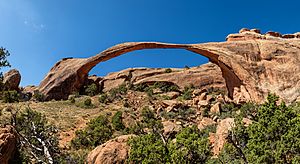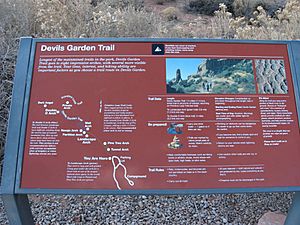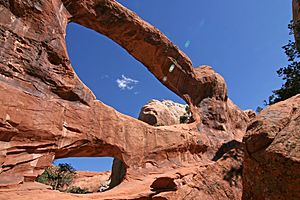Devils Garden (Arches National Park) facts for kids
Devils Garden is a special area inside Arches National Park in Utah, United States. It's known for its amazing rock formations, like tall, thin rock walls called fins and giant natural arches. These shapes were created over millions of years by erosion, which is when wind and water slowly wear away rock.
You can explore Devils Garden on the Devils Garden Trail. This trail is about 7.2 miles (11.6 km) long if you hike all its parts. The main path leads to Landscape Arch, which is one of the longest natural arches in the world. It's only about 0.8 miles (1.3 km) to Landscape Arch from the start of the trail. Along the way, you can also see Tunnel Arch and Pine Tree Arch on short side trails.
If you're up for a longer and more challenging hike, there's a "primitive loop" trail. This loop takes you to other cool arches like Partition Arch, Navajo Arch, Double O Arch, and Private Arch. You can also see a tall rock tower called Dark Angel. The trailhead for Devils Garden is at the very end of the main park road. There's also a campground and an outdoor theater nearby.
Contents
History of Devils Garden
In the early 1920s, a man from Hungary named Alexander Ringhoffer explored a similar area of rock fins and arches. He called that area "Devil's Garden." Ringhoffer told a railroad company about the beautiful landscape. The railroad company thought it would be a great place for tourists to visit.
They contacted the National Park Service, hoping the area could become a protected site. On April 12, 1929, President Herbert Hoover signed an order that created Arches National Monument. The monument had two main parts: the Windows section and Devils Garden. The name "Devils Garden" was taken from Ringhoffer's original name. Arches remained a national monument until 1971, when it officially became a national park.
Exploring Devils Garden
The Devils Garden trailhead and campground are about 18 miles (29 km) from the park's entrance. The trail system, including the primitive loop and side paths, covers about 7.2 miles (11.6 km).
The main trail to Landscape Arch is an easy, graded gravel path. It's about 0.8 miles (1.3 km) to reach Landscape Arch. On your way, you can take short detours to see Tunnel Arch and Pine Tree Arch.
The primitive loop trail is more difficult. It has steep sections and parts that are close to drop-offs. This loop takes you to other arches like Partition Arch, Navajo Arch, Double O Arch, and Private Arch. You can also see the Dark Angel monolith and Fin Canyon from this trail. Sadly, Wall Arch, another arch in this area, collapsed in 2008.
How the Rocks Formed
The tall, thin rock walls you see in Devils Garden are called sandstone fins. These fins were created when cracks in a thick layer of sandstone got wider. Water from rain and melting snow flowed into these cracks. Over time, the water wore away the rock. Ice expanding in the cracks also helped to break the rock apart.
These rock formations don't last forever. They might only stand for a few thousand years, which is a very short time in Earth's long history. The process that created these arches and fins began about 300 million years ago. At that time, seas covered the area many times. When the seas dried up, they left behind thick salt beds, some as deep as 5,000 feet (1,500 m).
Over millions of years, sand, silt, and clay piled up on top of the salt. The heavy weight of these layers squeezed the salt, pushing it upward into a dome shape. This caused the rock layers above to bulge and crack vertically. Rainwater then trickled down these cracks and dissolved the salt.
As the salt disappeared, the overlying rock sank. This created valleys like Salt Valley, which is nearby. At the edges of these valleys, like where Devils Garden is, the cracked rock was pulled slightly apart. Rain and snow soaked into the vertical cracks, dissolving the minerals that held the sand together. This allowed the sand grains to be carried away by water. As the cracks widened, tall fins were left standing. Weak spots in these fins were worn away by rainwater or broken apart by freezing and thawing water. These openings eventually grew into the beautiful natural arches we see today.
Landscape Arch is one of the longest natural arches in the world. It spans about 290 feet (88 m) across. It's only about 6 feet (1.8 m) thick near its center. In September 1991, a large slab of rock, about 60 feet (18 m) long, fell from the underside of the arch. You can still see some of these large boulders on the slope below the arch.
Plants and Animals
The main plants you'll see in Devils Garden are pinyon pines and junipers. The amount of wildflowers that grow each year depends on how much rain the area gets. April and May are usually the best months to see flowers blooming. Early fall can also be good if there have been many summer storms.
Many animals live in the park. You might spot cougars, mule deer, desert bighorn sheep, red foxes, cottontail rabbits, and kangaroo rats. There are also different types of lizards, like western collared lizards and desert spiny lizards. You might even see a midget faded rattlesnake.
Images for kids
See also
 In Spanish: Jardín del Diablo para niños
In Spanish: Jardín del Diablo para niños






